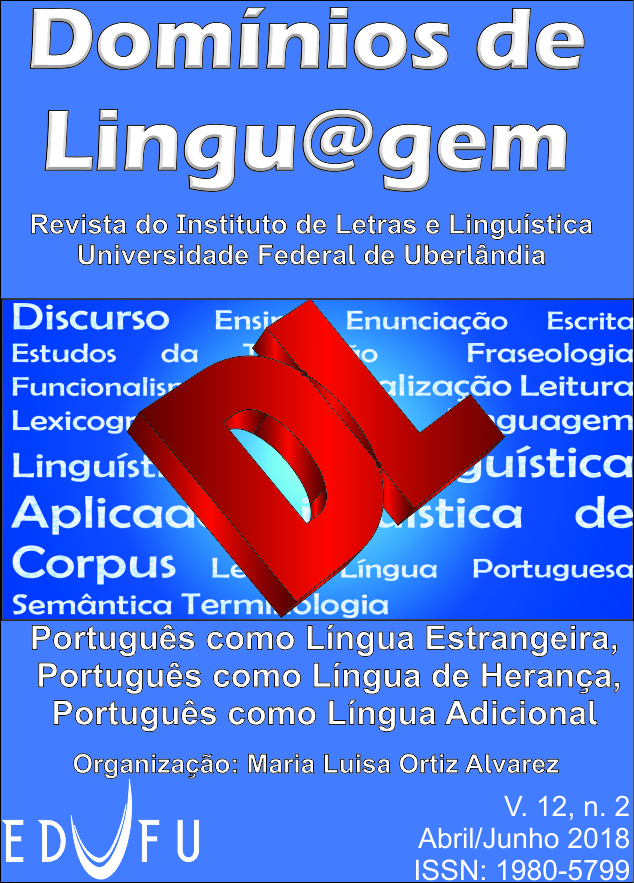Semantic and gender implications in feminine substantives
the teaching of Portuguese to immigrants who have French as a second language
DOI:
https://doi.org/10.14393/DL34-v12n2a2018-14Keywords:
Host Language, Portuguese to immigrants, Gender of nouns, Gender BendingAbstract
Based on observations made in classes of Portuguese to immigrants, it was possible to identify gender of nouns in the Portuguese language as a difficulty in learning the language. Because of the doubts that emerged during the lessons to immigrants, this work was developed from this guiding question: in the case of morphologically feminine nouns, why is there no perception of inclusion of the masculine gender? It was hypothesized that this difficulty is probably linked to the associations that immigrants make between Portuguese and their second language, French. In order to verify this hypothesis, tests were developed to understand the difficulty of gender differentiation in the acquisition of Portuguese as a Host Language. The tests’ application was structured as follows: firstly, the volunteer participants, 4 (four) Portuguese learners, had to identify the gender of semantically disconnected words, then in a context of simulated use, and finally through online processing, in which students were asked orally about the reasons for their choices in textual questions. From the analysis of the findings, it is possible to verify that the knowledge of other languages, mainly of French in this case, influences a lot in the learning of another language.Downloads
Metrics
References
ANTUNES, I. Muito além da gramática: por um ensino de línguas sem pedras no caminho. São Paulo: Parábola Editorial, 2007.
GROSSO, M. J. dos R. Língua de acolhimento, língua de integração. In: Horizontes de Linguística Aplicada. v. 9, n.2, p. 61-77, 2010. Disponível em http://periodicos.unb.br/index.php/horizontesla/article/viewArticle/5665. Acesso em 22 out. 2017.
KOLODNY, R. S. Marcação de gênero e classe temática em português e em francês (Monografia). Porto Alegre: UFRGS, 2016. Disponível em https://www.lume.ufrgs.br/bitstream/handle/10183/157915/001019994.pdf?sequence=1. Acesso em 23 jun. 2017.
LIMA, D. C. de (Org.). Diálogo aberto com Kanavillil Rajagopalan (Rajan) (entrevista). v. 1. n. 1. Vitória da Conquista: Fólio - Revista de Letras, jan/jun 2014, p. 11-22. Disponível em http://periodicos.uesb.br/index.php/folio/article/view/2964. Acesso em 07 jul. 2017.
NEVES, M. H. de M. Subsídios teórico-metodológico para o tratamento escolar da gramática. In: TOLDO, C. S. (org.). Questões de lingüística. Passo Fundo: UPF, 2005. p. 88-105.
PALUMA, V. C. G.; RESENDE, B. N. A interferência da língua materna (português brasileiro) no aprendizado de língua estrangeira (francês). In: IX Encontro Interno e XIII Seminário de Iniciação Científica - UFU. Uberlândia: Universidade Federal de Uberlândia, 2009.
PIANTÁ, P. B. O desenvolvimento da consciência metalinguística analisada em diferentes contextos bilíngues no Brasil. Porto Alegre: UFRGS, 2011. Disponível em http://www.lume.ufrgs.br/bitstream/handle/10183/32877/000786753.pdf?sequence=1. Acesso em 22 out. 2017.
PINTO, J. Transferências lexicais na aquisição de português como língua terceira ou língua adicional: Um estudo com alunos universitários em Marrocos. Diacrítica [online], v. 26, n. 1. 2012. p. 172-188. Disponível em http://www.scielo.mec.pt/scielo.php?script=sci_abstract&pid=S0807-89672012000100008. Acesso em 07 jul. 2017.
TOASSI, P. F. P.; MOTA, M. B. Transferência linguística no nível sintático na produção do inglês como terceira língua. Laureate International Universities. v. 2, n. 21, outubro de 2013. Porto Alegre: Nonada, Letras em Revista, 2013. Disponível em http://www.redalyc.org/pdf/5124/512451671026.pdf. Acesso em 07 jul. 2017.
TRAVAGLIA, L. C. Gramática ensino plural. 5. ed. São Paulo: Cortez, 2011.
Downloads
Published
How to Cite
Issue
Section
License
Authors who publish in this journal agree to the following terms:
Authors retain the copyright and waiver the journal the right of first publication, with the work simultaneously licensed under the Creative Commons Attribution License (CC BY-NC-ND 4.0), allowing the sharing of work with authorship recognition and preventing its commercial use.
Authors are authorized to take additional contracts separately, for non-exclusive distribution of the version of the work published in this journal (publish in institutional repository or as a book chapter), with acknowledgment of authorship and initial publication in this journal.









